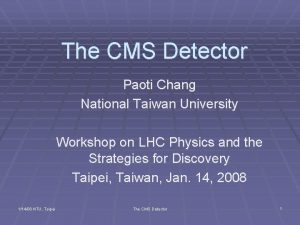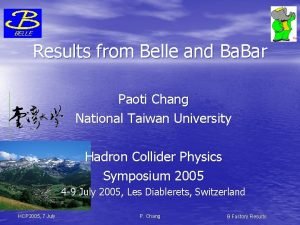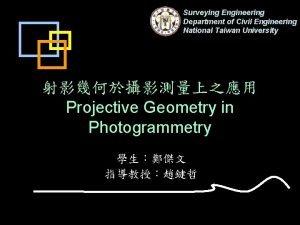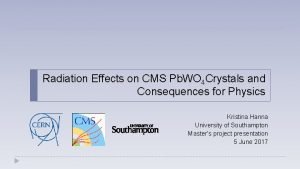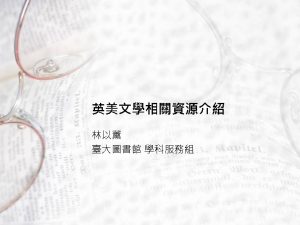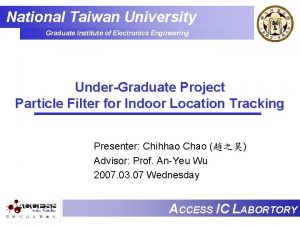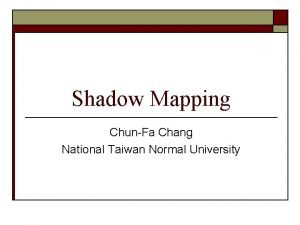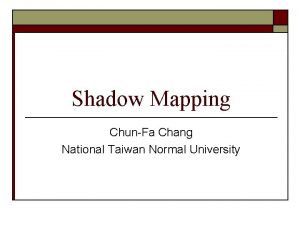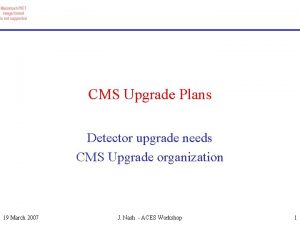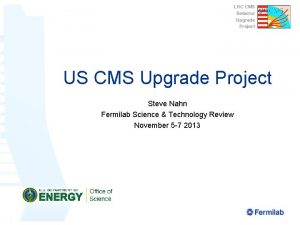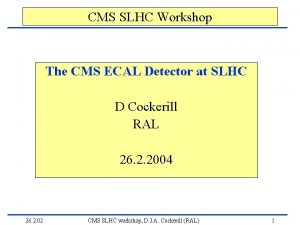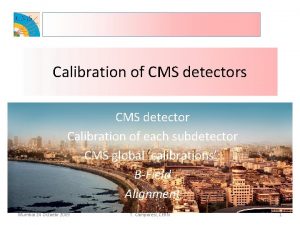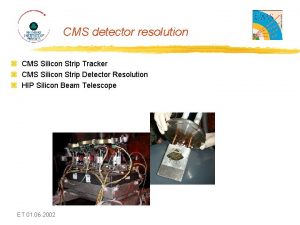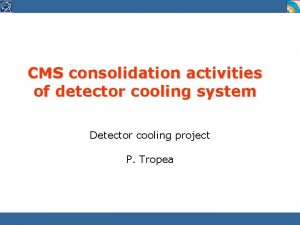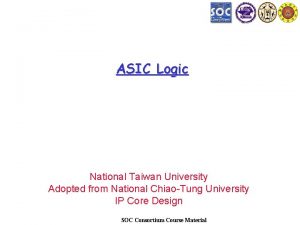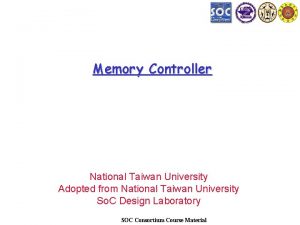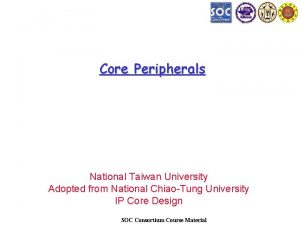The CMS Detector Paoti Chang National Taiwan University















































- Slides: 47

The CMS Detector Paoti Chang National Taiwan University Workshop on LHC Physics and the Strategies for Discovery Taipei, Taiwan, Jan. 14, 2008 1/14/08 NTU, Taipei The CMS Detector 1

Detector Requirement Good Muon identification; good dimuon mass resolution (~1% at 100 Ge. V); distinguish charge at 1 Te. V. n Good momentum resolution for charged tracks. Efficient triggering and off-line tagging on t and b-jets. n Good EM energy resolution; good diphoton and dielectron mass resolution; wide geometrical coverage; p 0 rejection and efficient photon and lepton isolation n Good missing-transverse-energy and dijet mass resolution high-field solenoid, full-silicon-based inner tracking system and a homogenous scintillating-crystal-based electromagnetic calorimeter n 1/14/08, NTU, Taipei The CMS Detector 2

Overview of the CMS Detector 1/14/08, NTU, Taipei The CMS Detector 3

Superconducting Magnet Special features: 1. Winding composed of four layers 2. Mechanically reinforced with aluminum alloy 3. Large dimension 6. 2 m cold bore, 12. 5 m length, 220 -t mass 1/14/08, NTU, Taipei The CMS Detector 4

Main parameters 1/14/08, NTU, Taipei CMS decides to use lower field, 3. 8 T. The CMS Detector 5

CMS Barrel Yoke ready for coil and muon Detector 1/14/08, NTU, Taipei The CMS Detector 6

Inner Tracking System n n Provide precise measurements of track trajectories and secondary vertices. L= 1034 cm-2 s-1 1000 particles from >20 inter. high granularity and fast response of electronics ⇕ Keeping minimum amount of material n 3 layers of pixel to reduce occupancy (4. 4 -10. 2 cm) 10 layers of silicon strip detectors (R ~ 1. 1 m) endcaps: 2 disk pixel and 3 plus 9 strip on each side 1/14/08, NTU, Taipei The CMS Detector 7

Overview of the tracker layout Acceptance |h|<2. 5, 200 m 2 silicon area, 1440 pixel and 15148 strip modules. pixel: 100 x 150 mm 2; Inner silicon: 10 cm x 80 mm; outer silicon: 25 cm x 180 mm 1/14/08, NTU, Taipei The CMS Detector 8

Expected Hadron Fluence and Radiation Dose L = 500 fb-1, 10 years of LHC running l Surface damage on readout chips 0. 25 mm CMOS chip (rad. hard) l Increasing leakage current low temperature -10 C to -27 C l transient phenomena 1/14/08, NTU, Taipei The CMS Detector 9

Pixel Detector Layout overview barrel support structure material budget 1/14/08, NTU, Taipei The CMS Detector 10

Barrel Pixel Detector Modules 1/14/08, NTU, Taipei The CMS Detector 11

Forward Pixel Sketches of two types of FPix panels Half cylinders Sketch of of a plaquette mounted in a panel 1/14/08, NTU, Taipei The CMS Detector 12

Status of Pixels 1/14/08, NTU, Taipei The CMS Detector 13

Overview of Silicon Strip Detector 1/14/08, NTU, Taipei The CMS Detector 14

Silicon sensor 320 mm sensors Active region 1/14/08, NTU, Taipei 500 mm sensors The CMS Detector 15

Silicon Tracker Inner Barrel and Endcap Exploded views of a module of two sensors Three TIB modules in a shell 1/14/08, NTU, Taipei The CMS Detector 16

Outer Silicon Tracker Each sector consists of 9 front petals and 9 back petals d = 2. 3 m TOB wheel 1/14/08, NTU, Taipei Endcap outer silicon strip detectors The CMS Detector 17

Rod an Petal Double sided rod Front and back panels for TEC 1/14/08, NTU, Taipei The CMS Detector 18

Expected Performance Transverse momentum 1/14/08, NTU, Taipei Impact parameter in r The CMS Detector Impact parameter in z 19

Electromagnetic Calorimeter The CMS ECAL consists of a hermetic homogenous calorimeter made of 61200 lead tungstate (Pb. WO 4) crystals in the central barrel part, ~7324 crystals in each of the two endcaps, and a preshower detector in front of the endcap crystals. n Advantages of Pb. WO 4: 1. high density (8. 28 g/cm 3); 2. shorter rad. Length (. 89 cm) 3. short Moliere radius (2. 2 cm); 4. fast radiation decay time (80% of the light in 25 ns) fine granularity, radiation hardness and compact calor. n 1/14/08, NTU, Taipei The CMS Detector 20

CMS-Pb. WO 4 1/14/08, NTU, Taipei The CMS Detector 21

Layout of the CMS ECAL Barrel: |h| < 1. 479 360 fold in f 2 x 85 fold in h crystal size: Endcap: front: 22 x 22 mm 2 1. 479< |h| < 3. 0 1 unit = 5 x 5 crystals. back: 26 x 26 mm 2 length: 230 mm 25. 8 X 0 1/14/08, NTU, Taipei crystal size: length: 220 mm The CMS Detector 24. 7 X 0 front: 28. 62 x 28. 62 mm 2 back: 30 x 30 mm 2 22

ECAL Modules Barrel supermodule (1700 crystals) Module of 200 crystals 1/14/08, NTU, Taipei The CMS Detector 23

ECAL-Barrel 1/14/08, NTU, Taipei The CMS Detector 24

Preshower Detector n n n 1. 653<|h|<2. 6; total length 20 cm. Twp parts: lead radiators and silicon strip sensors. Taiwan involvement: NCU: 1/4 silicon sensors NTU: System Motherboards 1/14/08, NTU, Taipei The CMS Detector 25

Calibration and Resolution channel-to-channel variation: use lab. measurements on light yields and photo-dio. response. 5% in barrel and 10% in endcap n Beam test n p 0/h →gg in data; w →en. n Laser Monitor system n Energy resolution n 1/14/08, NTU, Taipei The CMS Detector 26

Performance of a typical 3 x 3 crystals 1/14/08, NTU, Taipei The CMS Detector 27

Status of ECAL Endcaps & Preshower: testing micro modules, motherboards and preparing to install in April 1/14/08, NTU, Taipei The CMS Detector 28

Longitudinal View of the CMS Det. HCAL Barrel HCAL Endcap 1/14/08, NTU, Taipei The CMS Detector HCAL Forward 29

HCAL Barrel (HB) n n The HB consists of two half-barrels, each of which contains 18 wedges. Each wedge corresponds to 4 f sectors. The absorber consists of a 40 -mm thick front steel plate, 8 50. 5 -mm-thick brass plates, 6 56. 6 -mm-thick 16 h brass plate, and a 75 -mm-thick steel back plate. 5. 82 l. I at 90 and 10. 6 l. I at h=1. 3 1/14/08, NTU, Taipei wedge Half barrel The CMS Detector 30

The HCAL Tower Segmentation Plastic scintillators 1/14/08, NTU, Taipei The CMS Detector 31

Endcap Calorimeter (HE) Yoke Close to magnet, nonconducting absorber has to be used. C 26000 cartridge brass 1/14/08, NTU, Taipei The CMS Detector 32

HCAL Endcaps Scintillator Tray HE Wedges 1/14/08, NTU, Taipei The CMS Detector 33

Forward Calorimeter Situate at |h| = 5 n Detect particles through its Cherenkov light. Require good EM response (electrons). n Serve as luminosity monitor Methods: zero counting and average ET per tower n 1/14/08, NTU, Taipei The CMS Detector 34

Expected Performance Jet energy resolution 1/14/08, NTU, Taipei The CMS Detector 35

Muon System n n Identify muons, measure momentum and trigger muon events. The muon system consists of three types of gaseous detectors: 1. four layers of drift tubes in |h|<1. 2 2. cathode strip chamber covering |h| to 2. 4 3. resistive plate chambers 6 layers in barrel and 3 in endcaps ( |h| < 1. 6 ) 1/14/08, NTU, Taipei The CMS Detector 36

Layout of Drift Tube Chambers One layer is inside the yoke, one is outside, and the other two are embedded within the york. One of the five wheels. 60 chambers in the first three layers and 70 in the last. 1/14/08, NTU, Taipei The CMS Detector 37

Sketch of Drift-Tube Cell Gas: 85% Ar + 15% CO 2 Top and bottom plates are grounded. The voltages applied to the electrode are +320 V for wires, +1800 V for the strips and -1200 V for the cathode. 1/14/08, NTU, Taipei The CMS Detector 38

Installation of MB 1 on Wheel 2 Each DT chamber is made of 3 (or 2) superlayers, each of which is made of 4 layers of rectangular drift cells. 1/14/08, NTU, Taipei The CMS Detector 39

Quarter view of the CMS Detector 1/14/08, NTU, Taipei The CMS Detector 40

Layout of a CSC & a Schematic View of a Single Gap HV: 3. 5 -3. 9 k. V 7 trapezoidal panels forming a 6 gas gaps. 1/14/08, NTU, Taipei Gas: 40% Ar + 50% CO 2 + 10% CF 4 The CMS Detector 41

Resistive Plate Chamber Advantage: tagging the ionizing time much shorter than 25 ms good for triggers Gas: 96. 2% C 2 H 2 F 4 + 3. 5% C 2 H 10 + 0. 3% SF 6 1/14/08, NTU, Taipei The CMS Detector 42

Schematic Layout for Barrel RPC r-f view 1/14/08, NTU, Taipei The CMS Detector 43

Layout for Endcap RPC 1/14/08, NTU, Taipei The CMS Detector 44

Expected Performance 1/14/08, NTU, Taipei The CMS Detector 45

Status of the Muon System 1. DT muons: 2. a. Install tower electronics b. Test and commission 3. 2. CSC 4. a. All chambers and electronics are installed. B. Do more tests. 1/14/08, NTU, Taipei The CMS Detector 46

Summary n After so many year hardwork, majority of the n n n detector and electronics are installed and commissioned. Problems and difficulties are foreseen before collisions. Tight schedule for Endcap ECAL and Preshower. Keep testing and looking forward to LHC physics. 1/14/08, NTU, Taipei The CMS Detector 47
 08ntu
08ntu Ksk+
Ksk+ National taiwan university civil engineering
National taiwan university civil engineering Cms detector
Cms detector National science council taiwan
National science council taiwan Providence university taiwan ranking
Providence university taiwan ranking National medicare training program
National medicare training program Hát kết hợp bộ gõ cơ thể
Hát kết hợp bộ gõ cơ thể Frameset trong html5
Frameset trong html5 Bổ thể
Bổ thể Tỉ lệ cơ thể trẻ em
Tỉ lệ cơ thể trẻ em Voi kéo gỗ như thế nào
Voi kéo gỗ như thế nào Chụp phim tư thế worms-breton
Chụp phim tư thế worms-breton Chúa yêu trần thế alleluia
Chúa yêu trần thế alleluia Môn thể thao bắt đầu bằng chữ đua
Môn thể thao bắt đầu bằng chữ đua Thế nào là hệ số cao nhất
Thế nào là hệ số cao nhất Các châu lục và đại dương trên thế giới
Các châu lục và đại dương trên thế giới Công của trọng lực
Công của trọng lực Trời xanh đây là của chúng ta thể thơ
Trời xanh đây là của chúng ta thể thơ Mật thư tọa độ 5x5
Mật thư tọa độ 5x5 Làm thế nào để 102-1=99
Làm thế nào để 102-1=99 Phản ứng thế ankan
Phản ứng thế ankan Các châu lục và đại dương trên thế giới
Các châu lục và đại dương trên thế giới Thơ thất ngôn tứ tuyệt đường luật
Thơ thất ngôn tứ tuyệt đường luật Quá trình desamine hóa có thể tạo ra
Quá trình desamine hóa có thể tạo ra Một số thể thơ truyền thống
Một số thể thơ truyền thống Cái miệng xinh xinh thế chỉ nói điều hay thôi
Cái miệng xinh xinh thế chỉ nói điều hay thôi Vẽ hình chiếu vuông góc của vật thể sau
Vẽ hình chiếu vuông góc của vật thể sau Biện pháp chống mỏi cơ
Biện pháp chống mỏi cơ đặc điểm cơ thể của người tối cổ
đặc điểm cơ thể của người tối cổ Thứ tự các dấu thăng giáng ở hóa biểu
Thứ tự các dấu thăng giáng ở hóa biểu Vẽ hình chiếu đứng bằng cạnh của vật thể
Vẽ hình chiếu đứng bằng cạnh của vật thể Tia chieu sa te
Tia chieu sa te Thẻ vin
Thẻ vin đại từ thay thế
đại từ thay thế điện thế nghỉ
điện thế nghỉ Tư thế ngồi viết
Tư thế ngồi viết Diễn thế sinh thái là
Diễn thế sinh thái là Các loại đột biến cấu trúc nhiễm sắc thể
Các loại đột biến cấu trúc nhiễm sắc thể Bảng số nguyên tố
Bảng số nguyên tố Tư thế ngồi viết
Tư thế ngồi viết Lời thề hippocrates
Lời thề hippocrates Thiếu nhi thế giới liên hoan
Thiếu nhi thế giới liên hoan ưu thế lai là gì
ưu thế lai là gì Sự nuôi và dạy con của hươu
Sự nuôi và dạy con của hươu Khi nào hổ con có thể sống độc lập
Khi nào hổ con có thể sống độc lập Sơ đồ cơ thể người
Sơ đồ cơ thể người Từ ngữ thể hiện lòng nhân hậu
Từ ngữ thể hiện lòng nhân hậu
